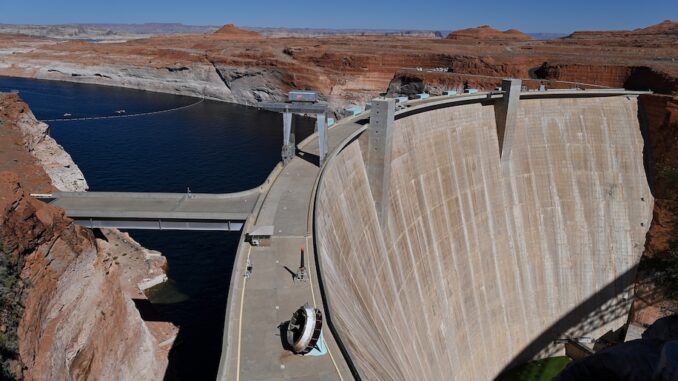
LAS VEGAS — The water managers responsible for divvying up the Colorado River’s dwindling supply are painting a bleak portrait of a river in crisis, warning that unprecedented shortages could be coming to farms and cities in the West and that old rules governing how water is shared will have to change.
State and federal authorities say that years of overconsumption are colliding with the stark realities of climate change, pushing Colorado River reservoirs to such dangerously low levels that the major dams on the river could soon become obstacles to delivering water to millions in the Southwest.
The federal government has called on the seven Western states that rely on Colorado River water to cut usage by 2 to 4 million acre-feet — up to a third of the river’s annual average flow — to try to avoid such dire outcomes. But the states have so far failed to reach a voluntary agreement on how to make that happen, and the Interior Department may impose unilateral cuts in coming months.
“Without immediate and decisive actions, elevations at Lake Powell and Mead could force the system to stop functioning,” Tommy Beaudreau, the Interior Department’s deputy secretary, told a conference of Colorado River officials here Friday. “That’s an intolerable condition that we won’t allow to happen.”
Many state water officials fear they are already running out of time.
Ted Cooke, general manager of the Central Arizona Project, which delivers Colorado River water to central Arizona, said that “there’s a real possibility of an effective dead pool” within the next two years. That means water levels could fall so far that the Glen Canyon and Hoover dams — which created the reservoirs at Lake Powell and Lake Mead — would become an obstacle to delivering water to cities and farms in Arizona, California and Mexico.
“We may not be able to get water past either of the two dams in the major reservoirs for certain parts of the year,” Cooke said. “This is on our doorstep.”
The looming crisis has energized this annual gathering of water bureaucrats, the occasional cowboy hat visible among the standing-room-only crowd inside Caesars Palace. It’s the first time the conference has sold out, organizers said, and the specter of mass shortages looms as state water managers, tribes and the federal government meet to hash out how to cut usage on an unprecedented scale.
“I can feel the anxiety and the uncertainty in this room and in the basin,” said Camille Calimlim Touton, commissioner of the Bureau of Reclamation.
Now the Biden administration has launched a new environmental review for distributing Colorado River supplies in low-water scenarios. Water managers hope to have more clarity on what states can offer by the end of January. By summer, the federal government is expected to define its authority to impose unilateral cuts.
“Unfortunately, it’s a year later than we need it,” Cooke said in an interview.
Across the West, drought has already led to a record number of wells running dry in California, forced huge swaths of farmland to lie fallow and required homeowners to limit how much they water their lawns. This week, a major water provider in Southern California declared a regional drought emergency and called on those areas that rely on Colorado River water to reduce their imported supplies.
The problems on the river have been building for years. Over the past two decades, during the most severe drought for the region in centuries, Colorado River basin states have taken more water out of the river than it has produced, draining the reservoirs that act as a buffer during hard times. The average annual flow of the river during that period has been 13.4 million acre-feet — while users are pulling out an average of 15 million acre-feet per year, said James Prairie, research and modeling group chief at the Bureau of Reclamation.
In 1999, Lake Mead and Lake Powell, the two largest reservoirs in the country, held 47.6 million acre-feet of water. That has fallen to about 13.1 million acre-feet, or 26 percent of their capacity. An acre-foot equals 326,000 gallons, or enough to cover an acre of land in a foot of water.
Federal officials have projected that, as soon as July, the level in Lake Powell could fall to the point where the hydroelectric plant inside the Glen Canyon Dam could no longer produce power, and then keep falling so that it would become impossible to deliver the quantities of water that Southwest states rely on. Water managers say such a “dead pool” is also possible on Lake Mead within two years.
“These reservoirs have served us for 23 years, but we’re now pushing them to their limits,” Prairie said.
David Palumbo, the Bureau of Reclamation’s deputy commissioner of operations, stressed that the effects of climate change — a hotter and drier West, where the ground absorbs more runoff from mountain snow before it reaches the reservoirs — means the past is no longer a useful guide to the future of the river. Even high snow years are now seeing low runoff, he said.
“That runoff efficiency is critical to be aware of and, frankly, to be afraid of,” he said.
Water managers say cuts are likely to hit hard in Arizona and California, where major farming regions consume big portions of the available supply. These states, which get water after it passes through Lake Mead and the Hoover Dam, also face the greatest risk if the reservoirs fall to dangerous levels, said John Entsminger, general manager of the Southern Nevada Water Authority.
“If you can’t get water through Hoover Dam, that’s the water supply for 25 million Americans,” he said.




